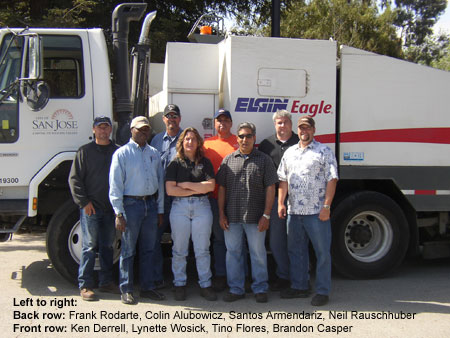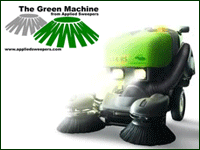Reader's Digest Clean Cities for 2006:
|

by Shelley Ross In March of 2006, Reader's Digest conducted an analysis of what makes for a clean city. Here's the criteria they used, followed by our own interviews with management representatives of the agencies handling sweeping. Perhaps this information can help your city make the list in the coming years! Here's an overview of the area and its challenges.The data used for San Jose included the counties of San Benito and Santa Clara. The following information in red print was reprinted from the Reader's Digest website. Background: This area's booming high-tech business during the 1980s and 1990s earned it the name Silicon Valley. Numerous semiconductor and computer chip manufacturers brought in huge numbers of highly educated workers, driving up house values and living costs. Then the dot-com bust hit, and San Jose suddenly lost 200,000 jobs. Now the city is seeking to reinvent itself as a center for innovation and research in such diverse fields as pharmaceuticals and automotives. Problems: In the early 1980s, a leaking underground storage tank filled with trichloroethane, a solvent suspected of causing reproductive and developmental problems, was found to be contaminating the drinking water of 65,000 people near a semiconductor plant. Over the next few years Silicon Valley became dotted with Superfund sites; at one time, Santa Clara County had more such sites than any other county in the country. Besides the high-tech contamination, the Valley's rapid growth resulted in extensive sprawl, which means traffic, and air pollution -- trapped by surrounding mountains. Solutions: The widespread pollution gave rise to a strong grass-roots environmental movement that pressured industry to clean up its mess. Industry responded by going the extra mile, setting higher standards for itself than required. The EPA, meanwhile, is overseeing the containment and cleanup of the Superfund sites. Because so much groundwater had been contaminated, the Santa Clara Valley Water District became a national leader in testing and protecting drinking water. As for its traffic woes, San Jose can thank the state of California for stricter regulations that have helped reduce the carbon monoxide and diesel particulates in the air. The bottom line for San Jose: It's a city now known nationwide for its clean streets, fresh air, and healthy lifestyle. Our Interview:

These days, the city of San Jose, California, glows Ð with clean streets, and with pride in those streets. Reader's Digest magazine for May 2006 has included San Jose in its Top Five Cleanest Cities in America, in the number two slot. Things weren't always so fine, though, and it took a plan and dedicated follow-up to leap to the top of this list. Kevin O'Connor, Deputy Director of Transportation for San Jose, told us, "First and foremost, our city dedicated itself to the belief that it has a responsibility to sweep all of its streets. It is simply unacceptable not to sweep all of them." San Jose has 4000 miles of curbs under its jurisdiction. In the year 2000, San Jose took a survey to determine how clean they were getting their streets. They found that they were receiving complaints both from the public and from city council members that the streets were not very clean. Next step was to investigate the reasons for shortfalls and formulate a plan to solve problems standing in the way of their goal. 
O'Connor described the detailed plan used by this city to take its streets from lackluster to top-rated. "We can point to a three-prong plan of operation that achieves our goal here. First, we actively manage and coordinate the activity among our in-house and contract sweeping programs, to make sure we're getting full and adequate coverage. Second, we have an active community outreach program, to involve and encourage cooperation by our citizens. Third, we actively seek out and then deal with problematic areas, to make sure that no street slips by," O'Connor explains. The job is accomplished by a combination of city and contract sweepers. "We have an in-house staff of five sweepers that do all of our arterial road and bikeway sweeping, performed every one to two weeks depending on need. Contract firms sweep our residential streets, and a third contract focuses on sweeping our downtown core twice a week. "I believe that a key component of our success in these past few years is actively managing and coordinating the activity among our in-house and contractual firms, to make sure we're using whichever method is most efficient to address particular streets and meet the needs of our customers. 
"Just as important, we have an active inspection program. We have a two-person inspection staff covering street sweeping and other operational issues in transportation. They are out there in the field every day, making sure the job is done according to expectations and communicating with the sweeping companies," O'Connor relates. The inspection program combines two-phases: the subjective day-to-day observations and regular objective assessments with a scorecard, of randomly selected streets, to track and monitor performance over time. The next step for the city was to identify areas that posed particular obstacles to its clean-streets goal. They saw that a major reason for streets not getting swept was parked cars in high-density population areas, where many residents have little choice but to park on the public streets. "When a car is parked on the street, you actually lose three car-lengths of sweeping distance, due to the amount of space a sweeper takes to swerve out into the street and then back to the curb to bypass that vehicle. If a street is 50% blocked by cars, the sweeper can access very little, if any, of the curb on that street," O'Connor explains. "So, we needed to make a very specific plan to clear those curbs for sweeping, and implement it with energy and determination. "We're now in our third year of installing parking prohibitions during street sweeping days. We sweep our residential streets once a month. We go in and sign a street with no-parking signs, setting up a window of two to four hours on a given day to clear the streets so sweepers can access the curbs. We provide community groups with flyers to hand out to neighbors and notices to put on cars about when sweeping day is coming and request that they please move their cars. We coordinate with the parking compliance officers, who go out ahead of the sweep and ticket cars that have not been moved. We've reached an 85% compliance rate or above in these areas. It's been very effective." The city also makes use of enhanced sweeping days, when they actually will tow away vehicles that are in violation of the temporary no-parking zone. "We clean these streets and demonstrate to the community that when we can get to these curbs, we can make your community look so much better. It's a pretty dramatic way to demonstrate our effectiveness and inspire their cooperation," remarks O'Connor. Community outreach contributes mightily to the success of this campaign. "We have an excellent resource in Lindsay Wolf and her Department of Environmental Services. They take a very strong role in public education, getting information out to our residents on the importance of street sweeping, the reasons we do it and how they can help us to keep their city clean. Information is provided on our city website, through regular mailings to our residents in their utility bills, and through hundreds of community and neighborhood groups of concerned citizens involved in improving their neighborhoods," says O'Connor. It all comes down to a commitment to achieving high performance standards. O'Connor concludes, "Our management philosophy is to engage our staff and inspire the attitude that we all have a responsibility to our city, to our taxpayers, to ourselves, to get these streets clean and to perform as well as we can. We've really turned the corner in the past year, getting all our staff on board. You can see the results." Recognition in a national magazine is a wonderful bonus. Kevin O'Connor, deputy director of transportation for the city of San Jose, CA. You may reach him via email sent to: kevin.o'connor@sanjoseca.gov
|
© 2006 World Sweeper
|
Street Contents
|